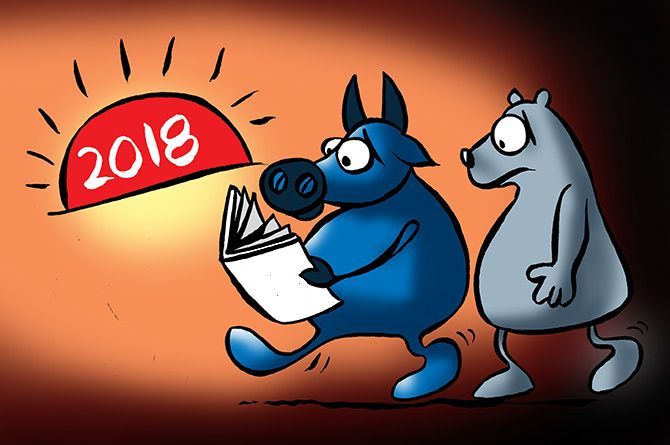'I would not term the market as a whole “buy on dips”.'
'There is more downside risk for the markets as compared to an upside potential right now.'
Illustration: Uttam Ghosh/Rediff.com

After the sharp fall from peak levels, the market recovery - even though partial - has been swift.
Mahesh Nandurkar, bottom, left, executive director and India Strategist at CLSA, talks to Puneet Wadhwa ahead of their 21st India Forum on his interpretation of how the markets have played out over the past few months, the road ahead, and his sector preferences in this backdrop. Edited excerpts:
What is your interpretation of how the markets have played out recently?
The market movement was sharp but did not come across as a surprise. We had been cautious for the past few months.
The primary concerns, apart from the valuations, included the rising interest rate environment and other macro indicators.
The correction, to some extent, brings valuations down to more reasonable levels. That said, they are still not in the “value buying” zone.
So, what is the comfort zone you are looking at in terms of valuation?
As things stand, the Nifty50’s current price-to-earnings (P/E) multiple is higher than the 10-year historical average.
Valuations in the other emerging markets are now trading below their historical averages.
A reason why India still has that premium is the inflow we continue to see from local investors into the equity mutual funds.
 As long as this sustains, the market premium will continue.
As long as this sustains, the market premium will continue.
If you look at the flow trend over the last few months, the extent of inflow has come down.
The key worry from here on is how these flows sustain.
The comfort zone for the market will be 5-10 per cent below the current levels.
Would you classify India as a “buy-on-dips” market?
Though the valuations have become more reasonable than before but still not in the comfort zone, I would not term the market as a whole “buy on dips”.
While there are certain segments that are looking better, there is more downside risk for the markets as compared to an upside potential right now.
Your outlook for foreign institutional investor (FII) flows?
Within the emerging markets (EMs), investors have cut their exposure to India, given valuation concerns and the macro picture (oil prices staying at an elevated level that impact India much more).
Though oil prices have softened, it is too early to say concerns on this front are over.
The rising interest rate environment and the political uncertainty ahead of the upcoming Assembly and Lok Sabha elections are playing on the minds of investors.
In this backdrop, FII flows are not likely to pick up anytime soon.
To what extent is the Assembly election outcome priced in?
Local investors will be more sensitive to the political developments.
One must recollect that the big change in local investor sentiment was visible in the monthly numbers (investment via mutual funds) starting May 2014, which coincided with the outcome of the Lok Sabha elections.
If the state election results were to raise doubts in the minds of investors about political certainty, it will impact flows into equities.
Of the five states going to the polls in November-December, the markets can still digest a loss in one state for the BJP.
A loss in two or more will see an adverse sentimental impact.
Your sector preferences?
We stay defensive in our choice of sectors.
There is more downside risk to the rupee and so to that extent we like the export-oriented sectors like IT services and pharma.
The consumption segment, especially the rural consumption space, looks good.
This is where government action will be ahead of the elections.
We also have a long-term structurally positive view on housing market recovery as well.
From that perspective, we like property developers and large housing finance companies (HFCs).
There has been a steady improvement in corporate-oriented banks where the gross non-performing asset (NPA) ratios have been coming down over the last two quarters.
So, selectively corporate banks are looking attractive. Telecom, cement and materials, and non-bank finance companies (NBFCs) are our underweight sectors.
Can you elaborate regarding NBFCs?
Our house view is that the interest rates will go up going ahead.
This will be incrementally negative for the wholesale-funded institutions like the NBFCs.
Banks that have been losing market share to NBFCs over the past two - three years is now set to change.
Therefore, we prefer private sector banks which will be relative beneficiaries over the NBFC segment.
What about corporate earnings?
For 2018-19, our earnings growth estimates have been coming down.
The September quarter (Q2FY19) results were disappointing where we saw estimates getting revised downwards across the board.
For FY19, earnings growth for Nifty50 is likely to come in at around 10 per cent.
We are much more optimistic for 2019-20 and project over 20 per cent earnings growth.
How will the market react should the RBI governor resign?
Any instability in the RBI can be a source of discomfort, especially for foreign investors, as the RBI clearly stands out as a central bank across the EMs in which investors have a lot of faith.











